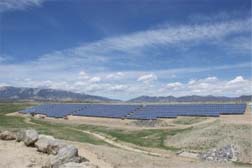DOI, DOE launch Solar Energy Zones on federally managed land
 Today the Departments of Energy and Interior (DOE and DOI, respectively) launched Solar Energy Zones on public lands in the U.S. West. The zones are part of the Obama Administration’s plans to make it easier for companies to install large solar facilities on public lands. It represents a major change in how such projects will be permitted and included a lengthy process of determining which lands are most suitable for solar, without impacting pristine environments and developing on previously disturbed lands.
Today the Departments of Energy and Interior (DOE and DOI, respectively) launched Solar Energy Zones on public lands in the U.S. West. The zones are part of the Obama Administration’s plans to make it easier for companies to install large solar facilities on public lands. It represents a major change in how such projects will be permitted and included a lengthy process of determining which lands are most suitable for solar, without impacting pristine environments and developing on previously disturbed lands.
Interior Secretary Ken Salazar officially signed the Record of Decision for the plan today (October 12) adopting it into DOI’s development guidelines. As part of the determination process DOI sought input from the public, which environmental organizations and other responded to with vigor. The result, a plan for more solar that keeps environmental and conservation groups like The Nature Conservancy happy. In the past, some environmental organizations have opposed some projects for their locations in the habitat areas of endangered or at-risk species.
“This federal solar plan is an important step forward in how energy can be smartly developed on our public lands,” said Michael Powelson, The Nature Conservancy’s North American director of Energy Programs. “The Nature Conservancy commends the Departments of Interior and Energy and the Bureau of Land Management for their commitment to find workable solutions that support renewable energy goals and protect the needs of people and nature,” he said
“The federal solar plan can serve as a model for how the Bureau of Land Management addresses all forms of energy development,” said Laura Crane, The Nature Conservancy, Director of the California Renewable Energy Initiative. “Honoring the zone approach agreed to by industry, utilities, conservation groups, and other stakeholders is critical to the success of the plan,” she said.
The DOI’s Solar Programmatic Environmental Impact Statement (PEIS) will allow land managed by the Bureau of Land Management (BLM) in Arizona, California, Colorado, Nevada, New Mexico, and Utah to be used for solar developments. In all, enough land was appropriated to generate enough power for 7 million homes in the U.S. The Nature Conservancy said it is the first time BLM has taken a proactive approach in identifying appropriate zones for energy development on public lands.



